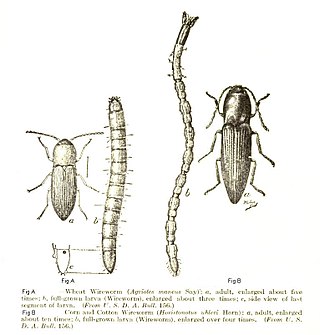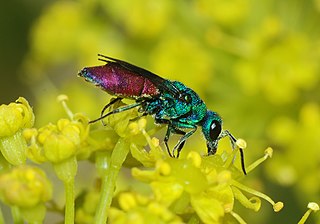
Elateridae or click beetles are a family of beetles. Other names include elaters, snapping beetles, spring beetles or skipjacks. This family was defined by William Elford Leach (1790–1836) in 1815. They are a cosmopolitan beetle family characterized by the unusual click mechanism they possess. There are a few other families of Elateroidea in which a few members have the same mechanism, but most elaterid subfamilies can click. A spine on the prosternum can be snapped into a corresponding notch on the mesosternum, producing a violent "click" that can bounce the beetle into the air. Clicking is mainly used to avoid predation, although it is also useful when the beetle is on its back and needs to right itself. There are about 9300 known species worldwide, and 965 valid species in North America.

Pyrophorus is a genus of click beetle. They are one of several genera in the tribe Pyrophorini, all of which are bioluminescent. Their bioluminescence is similar to that of another group of beetles, the fireflies, although click beetles do not flash, but remain constantly glowing. They have two luminescent spots at the posterior corners of the pronotum, and another brighter light organ on the most-anterior surface of the ventral abdomen. This light organ is even brighter and can only be seen when in flight. Bioluminescent click beetles are found throughout tropical, subtropical and temperate America. Species from Texas, Florida, Puerto Rico, and Cuba are now in different genera in the tribe Pyrophorini, such as Deilelater and Ignelater.
Selasia is a genus of beetles belonging to the family Elateridae, having historically been placed in the family "Drilidae", which was recently subsumed by Elateridae.

Otiorhynchus is a large genus of weevils in the family Curculionidae. Many species of the genus, particularly the black vine weevil and the strawberry root weevil, are important pests, both as larvae and as adults. Larvae feed on plant roots. Adults are flightless with fused elytra and feed at night on plant foliage. In many species of the genus at least some races are polyploid and parthenogenetic, while the rest of the races and species are diploid and bisexual. Otiorhynchus weevils, particularly O. scaber, have been a popular subject for studies of the evolution of parthenogenesis. The genus is native to the Palearctic region. However, sixteen species were inadvertently introduced to North America and have become widespread there.
Plastocerus is a genus of click beetles, the sole member of the subfamily Plastocerinae; while it has historically often been ranked as a family, the genus is now placed firmly within the family Elateridae.

Drilini is a tribe of beetles known commonly as the false firefly beetles, in the family Elateridae.

Hemicrepidius is a genus of click beetle belonging to the family Elateridae.

Chrysura is a genus of cuckoo wasps which parasitize megachilid bees. There are 117 species in Chrysura, all but 11 of which are found in the Palaearctic, making it the third largest genus in the family. The genus was described by Dahlbom in 1845, and the type species for the genus is Chrysura austriaca.

Chresmodidae is an extinct family of Mesozoic insects within the superorder Polyneoptera.
Dicromantispa electromexicana is an extinct species of mantidfly in the neuropteran family Mantispidae known from a fossil found in North America.

Elater is a genus of click beetle belonging to the family Elateridae.

Elaterinae is a subfamily of click beetles in the family Elateridae, containing 12 tribes worldwide.

Ampedini is a tribe of click beetles in the family Elateridae. There are about 7 genera and at least 80 described species in Ampedini.

Prosternon is a genus of click beetles belonging to the family Elateridae.
Vesperelater is a genus of click beetle. They are one of several genera in the tribe Pyrophorini, all of which are bioluminescent. Most of the species were formerly in the genus Pyrophorus.

Ampedus is a genus of click beetles in the family Elateridae. There are currently 461 recognized species of Ampedus beetles. It has a cosmopolitan distribution, but is found mostly in the Holarctic region, primarily in North America, Europe, and Asia. The oldest known fossil from this genus was found in Eocene Baltic amber, estimated to be from 38.0–33.9 million years ago.
Drasterius sulcatulus, is a species of click beetle found in India, Nepal, Pakistan, Sri Lanka, UAE and Oman.
Melanotus punctosus, is a species of click beetle found in India, Sri Lanka, Pakistan and Hawaii.

Diplostethus is a genus of click beetles in the family Elateridae. There are about six described species in Diplostethus, found in the Nearctic and the Neotropical Regions.

Dipropus is a genus of click beetles in the family Elateridae. There are around 150 described species in Dipropus, found in North, Central, and South America.













